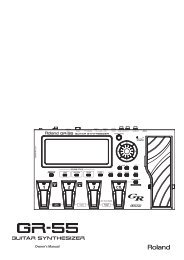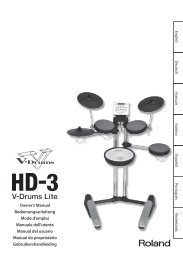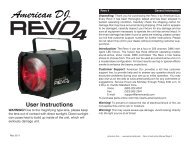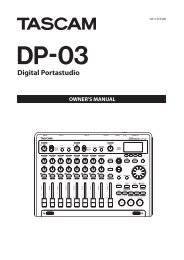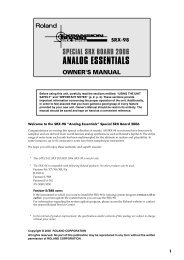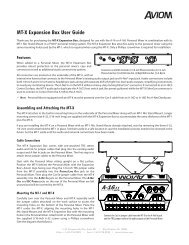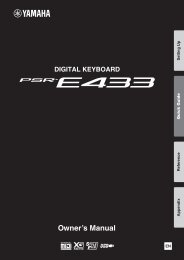Utilisation du dMIX-600 - UniqueSquared.com
Utilisation du dMIX-600 - UniqueSquared.com
Utilisation du dMIX-600 - UniqueSquared.com
Create successful ePaper yourself
Turn your PDF publications into a flip-book with our unique Google optimized e-Paper software.
Using the DMIX-<strong>600</strong><br />
Mixer Section (CONTINUED)<br />
.Gain/EQ section<br />
The DMIX-<strong>600</strong> has a 3 band EQ and Gain above each channel. The<br />
Gain may be used to set the audio level prior to the Line faders to<br />
achieve optimal audio volume. As well, you may use the<br />
HIGH/MID/LOW to adjust the Treble, Mid Range and Bass of your<br />
channel.<br />
Note-FOR OPTIMAL PERFORMANCE, BEGIN PROGRAM MIX WITH ROTARY<br />
GAIN CONTROLS SET TO MINIMUM (ROTATE IT COUNTERCLOCKWISE TO<br />
THE COUNTER CLOCKWISE POSITION). MAKE ALL ADJUSTMENTS IN<br />
SOUND OUTPUT WITH THE USE OF YOUR CHANNEL SLIDE CONTROLS AND<br />
MASTER VOLUME ROTARY CONTROLS. THIS WILL PREVENT SIGNAL OVER-<br />
LOAD AND DECREASE DISTORTION. ONCE YOU HAVE MODIFIED YOUR SOUND AND<br />
WOULD LIKE TO INCREASE THE OUTPUT OF YOUR SOUND, THEN YOU MAY<br />
ADJUST THE ROTARY GAIN CONTROL IF NEEDED<br />
Line and Cross Faders<br />
The next section of the DMIX-<strong>600</strong> is the mixer section are the Line and<br />
Cross Faders. The Line fader is the Volume Control of your channel-use it<br />
to adjust output volume of each indivi<strong>du</strong>al channel. The Crossfader on<br />
the other hand can be used to fade between each channel. The speed in<br />
which the volume <strong>com</strong>es in on each side of the Cross Fader can be controlled<br />
by the Fader Curve Switch, located above the Cross Fader.<br />
The Crossfader is user relaceable, and can be ordered from any<br />
Authorized Cortex dealer or from our own Tech Support department.<br />
Fig 8.3 -EQ/Gain/Input Select<br />
section of the Dmix <strong>600</strong><br />
VU Meter<br />
The VU meter can be used to view the volume level of both the Master<br />
output of your Dmix-<strong>600</strong> as well as the indivi<strong>du</strong>al channel output. This<br />
can be controlled by using the Cue/PGM switch located above the VU<br />
meter. Set the switch to CUE to view the volume of Channel 1 and<br />
Channel 2. Set the Switch to PGM to view the volume of the Master<br />
Output. To avoid distortion, try to keep the volume level of the Master<br />
Output at between 0 and +5dB on the VU meter.<br />
Cue Section<br />
The Cue section of the Dmix-<strong>600</strong> allows the user to preview Channels 1<br />
and 2 before fading them in to be heard through the Main output section.<br />
To use the Cue preview function, first plug in a set of headphones to<br />
the front mounted Headphone jack. Then, using the Cue fader located on<br />
the front right hand side of the unit, fade between the two channels. You<br />
may use the Cue Volume knob to increase or decrease volume going to<br />
the headphones. The CUE EFX button allows you to preview the effect<br />
that has been assigned to either channel in your headphones.<br />
Microphone Section<br />
The Microphone section of the Dmix-<strong>600</strong> allows for the user to plug in up<br />
to two microphones at the same time. Both microphone jacks are 1/4’‘ TS<br />
(Tip-Sleave) style jacks, and share both Volume and EQ controls which<br />
are located on the left hand side of the front panel. You can use the Mic<br />
High and Low controls to change the tone of the signal, and the Mic<br />
Volume control to change the overall volume. Again, please note that<br />
these controls alter both tone and volume of both the front and rear<br />
mounted microphone jacks.<br />
Fig 8.4 - Cue Section of the Dmix-<strong>600</strong><br />
Fig 8.5 -Microphone Section of the Dmix-<strong>600</strong><br />
27



